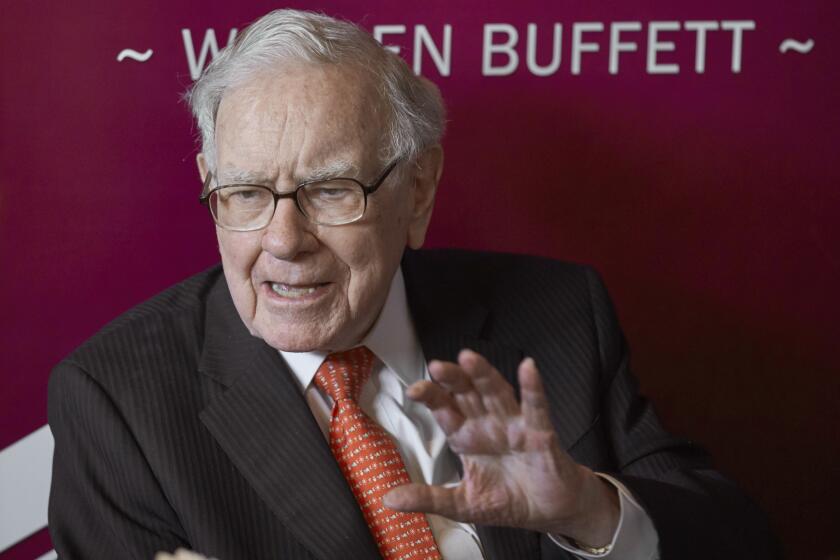Down-Home Documentaries Carry Home Savings’ Message
- Share via
Melvin Jones swears there was no script at all. “None,” he said. And Mary Ann Bixby insists nothing was planned--except that she doesn’t usually shampoo the dog while wearing her pink cable knit sweater.
You’ll be seeing a lot of the Jones and Bixby families during the next six months. And, for that matter, plenty of people like them. In a new campaign for Home Savings of America, they do pretty mundane things, such as swing on porch swings, wash down their driveways and, yes, even watch paint dry.
Sounds pretty boring, huh?
But the company hopes that viewers will identify not only with the things these people do, but also with what they say. It is using a documentary style to get its message across. In fact, its commercials are called “one-minute documentaries.” These are a backlash to the recent crop of flashy, multimillion dollar commercials that are vying for viewer attention. The one-minute documentaries do not use actors, but instead, attempt to capture real people--often customers--doing nothing more than simple things like chores around the house.
“The documentary-style camera may be the next hot thing,” said Edward Meyer, chairman and chief executive of the New York ad firm Grey Advertising. “It more intensely involves the viewer.”
Ad industry experts say there is one overriding reason this formula works: credibility. “Viewers know that celebrities are getting paid a lot of money, and that greatly discounts their credibility,” said Valerie S. Folkes, associate professor of marketing at USC. “But when you use an everyman in a commercial, the credibility soars.”
As a result, two California companies--Home Savings and Velvet Turtle Restaurants--have recently introduced ad campaigns that could just as well star your next door neighbor.
The $20-million Home Savings campaign is the Irwindale-based savings and loan’s attempt to cash in on the home loan demand that swells every spring. In its low-key commercials, none of the customers even mention the company’s name--they mostly talk about family values while watering the lawn or poking around in the garden.
The Velvet Turtle campaign is the Sunnyvale chain’s attempt at bucking the two-year trend toward flat sales in the restaurant industry. Its ads are shot in the restaurant as customers chow down while discussing everything from high school hangouts to the travails of growing up in Redondo Beach.
“It’s a much more lasting effect than telling people that they can buy a piece of your prime rib for $9.99,” said Rick Cough, vice president of marketing at Velvet Turtle.
The campaigns, however, are not as simple as they look.
Chiat/Day, the Los Angeles-based ad firm for Home Savings, spent two months interviewing 150 customers before selecting the eight families it used in its recent commercials. And Goodby, Berlin, Silverstein, the San Francisco-based agency for Velvet Turtle, videotaped interviews with 125 groups of customers before selecting four.
But it was the actual shooting of the commercials that really had the ad directors on edge. Each commercial required hours of shooting--but there were no scripts to follow.
“We didn’t write a word,” said Michael Aaron, vice president and management supervisor at Chiat/Day. And when no script and no actors are involved, “that can cause one to bite one’s fingernails,” said George M. Winston, senior vice president and director of marketing at Home Savings.
After all, there’s always the possibility that a crew will shoot for a day--but nothing really interesting will turn up. And there’s also that possibility that the customer will freeze when the camera starts to roll.
Dustin Jenson didn’t do so well when the camera was rolling. The 10-year-old fifth-grader from Gladstone, Kan., was a much better subject with the camera off. So, while standing outside his neighborhood pet shop, the Chiat/Day crew told the boy that they were reloading the camera. In fact, they filmed him for 20 minutes while he played with the cats in the window. “You can’t get actors to do those kinds of things,” said Rick Boyko, associate creative director.
Vons Account Keeps Three Shops Hopping
Everyone wants to get his foot into the More Store’s ad door.
The More Store, of course, is Vons, the supermarket chain whose image had been molded for 14 years by the West Coast office of Grey Advertising. But Grey dropped the $12-million account last month so it could chase after Lucky Stores, which is shopping for a new ad agency.
Among those in the hunt for the Vons account is Jack Roth, president and chief executive of Admarketing Inc. Roth, who says he usually refuses to make formal presentations to prospective clients, is so eager to land the Vons account that last week his Los Angeles agency made its first presentation in nearly a year.
Also in the running are J. Walter Thompson’s Los Angeles office and Keye/Donna/Pearlstein of Los Angeles. But even with the high costs involved in putting together these presentations, two of the three agencies will meet rejection. “I can’t think of any other industry where giving your service away free is the standard,” Roth said.
Vons--which has narrowed the prospective field to three--is scheduled to name its new agency this week. If Admarketing is selected, it would have to drop its Boys Market account, Roth said. “But even they told us we’d be crazy not to go after Vons.”
Kodak Wins Award for Continuing Excellence
Eastman Kodak Co. has to like the way things developed last week at the annual meeting of the American Assn. of Advertising Agencies in Boca Raton, Fla.
The photography giant walked off with the New York-based trade association’s second-annual Distinguished Advertising Award for Continuing Excellence.
With its “Open Me First” slogan in 1957, Kodak introduced a Christmas merchandising campaign that was the talk of the industry. In 1975, it was among the first companies to commission original music for an ad, with the song, “The Times of Your Life,” which later became a Paul Anka hit.
Kodak’s latest advertising thrust is a multimillion-dollar campaign aimed at getting business people to recognize the company as something more than a leader in photography. It highlights Kodak’s business and industrial products such as office copiers.
“It is a strategy designed to surprise people,” said Colby H. Chandler, chairman and chief executive at Kodak, “and to reposition perceptions about Kodak.”
LEADING AGENCIES
U.S. ad agency worldwide gross income jumped 11.5% to $8.65 billion in 1986, according to Advertising Age, the industry trade magazine that last week released its annual listing of the nation’s top 500 agencies. Because of the rash of recent industry mergers, Advertising Age publishes lists that separate U.S. ad agencies from their larger holding companies.
Top Five U.S. Agencies All figures in millions of dollars
‘86 world ’86 world Agency income billings Young & Rubicam 628.4 4,191 Saatchi & Saatchi Compton 490.5 3,320 Ted Bates Worldwide 486.5 3,261 J. Walter Thompson 471.0 3,141 Ogilvy & Mather Worldwide 459.6 3,154
Top Five Holding Companies All figures in millions of dollars
‘86 world ’86 world Agency income billings Saatchi & Saatchi PLC 1,209.6 8,255 Interpublic Group 822.4 5,552 Omnicom Group 820.1 5,586 JWT Group 644.8 4,300 Ogilvy Group 548.7 3,802
Top Five L.A.-Area Agencies All figures in millions of dollars
‘86 ’85 Agency billings billings Foote, Cone & Belding 229.0 225.0 Admarketing 184.0 170.5 Chiat/Day 141.0 151.1 Dailey & Associates 140.6 140.9 Bozell, Jacobs Kenyon & Eckhardt 121.5 85.5
More to Read
Inside the business of entertainment
The Wide Shot brings you news, analysis and insights on everything from streaming wars to production — and what it all means for the future.
You may occasionally receive promotional content from the Los Angeles Times.










